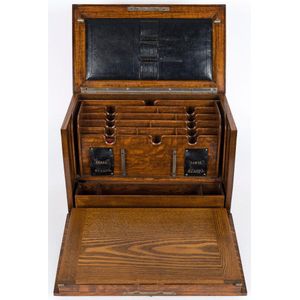19th Century Oak Writing Compendium with Fold-Out Slope
You must be a subscriber, and be logged in to view price and dealer details.
Subscribe Now to view actual auction price for this item
When you subscribe, you have the option of setting the currency in which to display prices to $Au, $US, $NZ or Stg.
- Compendium - A compendium is usually a wooden box that has several compartments and drawers for storing the various items. A stationery compendium would be used for storing and organizing various personal or business items including documents, business cards, passports, and other items that need to be organized and easily accessible. It is typically a wooden box t
A compendium for correspondence would usually have pockets for holding different sizes of envelopes, and sometimes may have a built-in address book or a calendar. It can also have a pen loop or holder, and sometimes a calculator.A compendium for games would usually have pockets for holding game pieces, cards and sometimes rule books. It can also have a space for a chess or checkers board.A sewing compendium would have compartments for thimbles, bobbins, needles etc. - Oak - Native to Europe and England, oak has been used for joinery, furniture and building since the beginning of the medieval civilisation. It is a pale yellow in colour when freshly cut and darkens with age to a mid brown colour.
Oak as a furniture timber was superceded by walnut in the 17th century, and in the 18th century by mahogany,
Semi-fossilised bog oak is black in colour, and is found in peat bogs where the trees have fallen and been preserved from decay by the bog. It is used for jewellery and small carved trinkets.
Pollard oak is taken from an oak that has been regularly pollarded, that is the upper branches have been removed at the top of the trunk, result that new branches would appear, and over time the top would become ball-like. . When harvested and sawn, the timber displays a continuous surface of knotty circles. The timber was scarce and expensive and was used in more expensive pieces of furniture in the Regency and Victorian periods.
This item has been included into following indexes:
Visually similar items

Ricketts, William (1898-1993), a hanging pottery plaque featuring the slightly turned face of an Aboriginal boy, with brown and beige colouring; having the inscribed signature 'Wm Ricketts' verso. Height 32 cm. Width 27 cm. Depth 11 cm

A collection of Australian Ephemera, including 1947-48 Indian cricket Team signatures, circa 1880's to mid 20th century, including 1884 Sydney, NSW, Marriage Licence; two 'The Lady Shenton Gold Miners 1934' share certificates; two 'Freney Kimberley Oil Com

Len Castle, hanging form, of rectangular ribbed stoneware, oxide washed with blue interior glaze, circa 1990, width 22 cm. Provenance: Purchased from Len Castle's personal collection.

John Paine (1834-1915), Large black leather-bound presentation album with gold embossed decorations. Contains a collection of Sydney and New South Wales images, circa 1890. 88 photographs, mostly titled in the image or in mss below, and mainly 14.5 x 20.5
